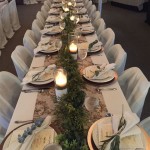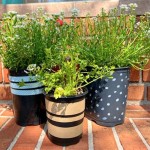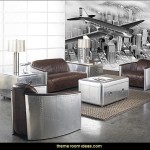```html
How to Decorate a Dining Table Tray: A Comprehensive Guide
A dining table tray serves as more than just a functional surface; it is an opportunity to enhance the aesthetic appeal of a dining space. By carefully curating its contents, a tray can transform a simple table into a captivating focal point. The following provides a comprehensive guide to decorating a dining table tray, detailing essential elements and considerations for creating a harmonious and stylish arrangement.
The initial step involves selecting the appropriate tray. The size, shape, and material of the tray should complement the overall design of the dining room and the dimensions of the table. Consider the table's shape and size when determining the ideal tray dimensions. For a round table, a round or square tray often works well, while a rectangular table benefits from a rectangular or oval tray. Material choices range from wood and metal to glass and acrylic, each offering a distinct aesthetic. Wooden trays bring a rustic, warm feel, metal trays offer a sleek, modern touch, and glass trays add a sense of elegance and airiness. The chosen material should align with the room's existing décor.
Choosing the Right Elements
Once the tray is selected, the next crucial step involves choosing the elements that will populate it. This selection process should prioritize a balanced mix of functional and decorative items, ensuring the tray is visually appealing while also serving a purpose. Common elements include candles, decorative objects, plants, and serving ware.
Candles are a versatile addition, capable of creating ambiance and adding a touch of warmth. Consider using candles of varying heights and textures to add visual interest. Scented candles can introduce a pleasant aroma to the dining area, but it's important to choose scents that are not overpowering or that clash with food aromas. Pillars candles, votives, and tea lights are all viable options, depending on the desired effect. Arrange them in clusters or scatter them amongst other decorative objects.
Decorative objects contribute to the overall aesthetic of the tray. These can include sculptures, figurines, decorative bowls, or unique pieces that reflect personal style. The scale of these objects should be proportionate to the size of the tray and the other elements within it. Avoid overcrowding the tray with too many small items, as this can create a cluttered look. Instead, opt for a few carefully chosen pieces that make a statement. Metal, ceramic, or glass objects can introduce textural contrast and visual interest.
Plants and flowers introduce a natural element to the tray, adding vibrancy and life. A small potted plant, such as a succulent or a miniature fern, can bring a touch of greenery to the dining table. Alternatively, a vase of fresh flowers can provide a pop of color and fragrance. Artificial plants are also a viable option, particularly for those who prefer a low-maintenance solution. When choosing plants, consider their size, shape, and color in relation to the other elements on the tray. Ensure the plant pot or vase complements the tray's overall design.
Serving ware can be incorporated into the tray's design to enhance its functionality. This can include a set of coasters, a sugar bowl and creamer, or a small pitcher for water or juice. The serving ware should be stylish and coordinated with the overall theme of the dining room. Choose pieces that are both practical and visually appealing. For example, a set of elegant coasters can protect the table from water rings while also adding a touch of sophistication. A decorative sugar bowl and creamer can enhance the coffee or tea service during meals.
Arranging the Elements for Visual Harmony
The arrangement of the elements within the tray is critical to achieving visual harmony. A well-arranged tray should be balanced, visually appealing, and functionally practical. Several key principles should guide the arrangement process.
The principle of balance dictates that the visual weight of the elements should be evenly distributed across the tray. This can be achieved through symmetrical or asymmetrical arrangements. A symmetrical arrangement involves mirroring the elements on either side of the tray, creating a formal and balanced look. An asymmetrical arrangement involves placing elements of different sizes and shapes in a way that creates a sense of visual equilibrium. This approach can be more dynamic and interesting than a symmetrical arrangement, but it requires careful consideration to avoid creating an unbalanced look.
Creating visual interest involves introducing variety in height, texture, and color. Varying the height of the elements can prevent the tray from appearing flat and monotonous. Use taller candles or plants to add vertical interest, and shorter objects to fill in the gaps. Mixing different textures, such as smooth glass, rough wood, and soft fabric, can add tactile appeal to the tray. Incorporating different colors can create a vibrant and engaging display. However, it's important to choose colors that complement each other and the overall color scheme of the dining room.
Functionality should also be considered when arranging the elements. Ensure that the items on the tray are easily accessible and do not obstruct the view across the table. Avoid overcrowding the tray, as this can make it difficult to access the items and create a cluttered appearance. Leave some empty space to allow the eye to rest and to create a sense of spaciousness. Consider the practical needs of the dining space when determining the placement of the elements. For example, if the tray is intended for use during mealtimes, ensure that the serving ware is easily accessible to guests.
Considerations for Different Dining Styles
The decoration of a dining table tray should also consider the overall style of the dining room. A minimalist dining room calls for a simple and understated tray arrangement, while a more traditional dining room can accommodate a more elaborate and decorative tray.
For a minimalist dining room, a simple tray with a few carefully chosen elements is often the most effective approach. Consider using a tray made of a natural material, such as wood or stone, and populate it with a small potted plant and a candle. Avoid clutter and unnecessary decorations. The focus should be on creating a clean and uncluttered look that complements the minimalist aesthetic of the room.
In a traditional dining room, a more elaborate tray arrangement can be used to enhance the room's formal and elegant atmosphere. Consider using a tray made of silver or gold, and populate it with a variety of decorative objects, such as figurines, candlesticks, and decorative bowls. Incorporate rich colors and textures, such as velvet or silk. The overall effect should be one of sophistication and refinement.
For a modern dining room, a sleek and contemporary tray arrangement can be used to complement the room's clean lines and minimalist design. Consider using a tray made of metal or glass, and populate it with a few carefully chosen geometric objects. Avoid clutter and excessive decoration. The focus should be on creating a stylish and understated look that enhances the modern aesthetic of the room.
In a rustic dining room, a tray made of wood or wicker can be used to enhance the room's warm and inviting atmosphere. Populate the tray with natural elements, such as pine cones, stones, and dried flowers. Incorporate rustic textures, such as burlap or linen. The overall effect should be one of comfort and charm.
Ultimately, the decoration of a dining table tray is a matter of personal preference. However, by following these guidelines and considering the overall style of the dining room, it is possible to create a tray arrangement that is both visually appealing and functionally practical.
```
Where Ideas For Your Home Meet Inspiration Heart Farmhouse Coffee Table Decor Dining Room Centerpieces Living

Why You Should Be Decorating With Trays And How To Do It Worthing Court

Tray Decor 1 4 Styles The Magic Brush Round Serving

Why You Should Be Decorating With Trays And How To Do It Worthing Court

Home Decor Ideas 6 Ways To Use Serving Trays In Your

Best Tips On How To Decorate A Serving Tray Lightlady Studio

Why You Should Be Decorating With Trays And How To Do It Worthing Court

A Diyer Guide To Creating Centerpiece Dining Room Table Decor Kitchen

Beautiful And Easy Dining Room Table Centerpiece Ideas Stonegable

Beautiful And Easy Dining Room Table Centerpiece Ideas Stonegable
Related Posts







